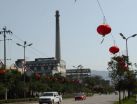(Press-News.org) Decreased exposure to air pollution in utero is linked with improved childhood developmental scores and higher levels of brain-derived neurotrophic factor (BDNF), a key protein for brain development, according to a study looking at the closure of a coal-burning power plant in China led by researchers at the Columbia Center for Children's Environmental Health at the Mailman School of Public Health.
The study is the first to assess BDNF and cognitive development with respect to prenatal exposure to polycyclic aromatic hydrocarbons (PAH), a component of air pollution commonly emitted from coal burning. Results appear online in the journal PLOS ONE.
The 2004 closure of a coal-burning power plant in Tongliang, China provided the opportunity to investigate the benefits to development and the impacts on BDNF associated with decreased levels of exposure to PAH. This study has linked decreases in air pollution with decreased levels of PAH-DNA adducts in cord blood, a biological marker of exposure, and reported an association between PAH exposure and adverse developmental outcomes in children born before the plant closure. Currently, coal-fired power plants produce more than 70% of China's electricity.
Deliang Tang, MD, DrPH, and his colleagues followed two groups of mother-child pairs from pregnancy into early childhood. One of the groups was comprised of mothers pregnant while the coal power plant was still open and the other after it closed. Developmental delay was determined using a standardized test, the Gesell Developmental Schedule (GDS), which was adapted for the Chinese population. The GDS assesses children in four areas: motor skills, learned behaviors, language, and social adaptation.
The researchers found that, as hypothesized, decreased PAH exposure resulting from the power plant closure was associated with both increased BDNF levels and increased developmental scores. PAH-DNA adducts were significantly lower in the babies born after the coal power plant shutdown as compared to those born before the closure, indicating a meaningful exposure reduction. Moreover, the researchers found that the mean level of BDNF was higher among children born after the closure of the power plant. The impacts of PAH exposure and BDNF on developmental scores was also analyzed considering all the children, including both the pre- and post-closure groups. Increased scores in the average, motor, and social areas were linked with higher levels of BDNF.
"The key to limiting the health impacts of environmental exposures is policy change supported by scientific evidence. These findings indicate that regulation can rapidly decrease exposure and improve health outcomes among the most sensitive populations, providing support for implementing additional measures such as the closure of the Tongliang coal-fired power plant," says Dr. Tang, director of the China studies at the Columbia Center for Children's Environmental Health and associate professor of Environmental Health Sciences at the Mailman School.
Additionally, the results provide important insight into the relationship between PAH exposure, BDNF, and developmental outcomes, and evidence for BDNF as a marker for the neurodevelopment effects of exposure to air pollution. More research is necessary to determine if the damage caused by environmental exposures, such as PAH, can be mitigated by presence of an enriched environment.
INFORMATION:
Support for the study was provided by the Energy Foundation, the Rockefeller Brothers Fund, and the Schmidt Foundation.
Additional authors include Frederica P. Perera, DrPH, PhD, director at the Columbia Center for Children's Environmental Health; Joan Lee, MPH; Loren Muirhead, MPH; Lirong Qu, MD; and Jie Yu, MD—also at the Center; and Ting Yu Li, MD, at Chongqing Medical University, Chongqing, China.
About Columbia University's Mailman School of Public Health
Founded in 1922, Columbia University's Mailman School of Public Health pursues an agenda of research, education, and service to address the critical and complex public health issues affecting New Yorkers, the nation and the world. The Mailman School is the third largest recipient of NIH grants among schools of public health. Its over 450 multi-disciplinary faculty members work in more than 100 countries around the world, addressing such issues as preventing infectious and chronic diseases, environmental health, maternal and child health, health policy, climate change & health, and public health preparedness. It is a leader in public health education with over 1,300 graduate students from more than 40 nations pursuing a variety of master's and doctoral degree programs. The Mailman School is also home to numerous world-renowned research centers including ICAP (formerly the International Center for AIDS Care and Treatment Programs) and the Center for Infection and Immunity. For more information, please visit http://www.mailman.columbia.edu.
Coal plant closure in China led to improvements in children's health
Decreased exposure to air pollution associated with increases in key protein in brain development
2014-03-26
ELSE PRESS RELEASES FROM THIS DATE:
Resistance is not futile
2014-03-26
Researchers with the U.S. Department of Energy (DOE)'s Joint BioEnergy Institute (JBEI), a multi-institutional partnership led by Berkeley Lab, have identified the genetic origins of a microbial resistance to ionic liquids and successfully introduced this resistance into a strain of E. coli bacteria for the production of advanced biofuels. The ionic liquid resistance is based on a pair of genes discovered in a bacterium native to a tropical rainforest in Puerto Rico.
"We identified two genes in Enterobacter lignolyticus, a soil bacterium that is tolerant to imidazolium-based ...
NASA catches Gillian as a super-cyclone before quickly dissipating
2014-03-26
VIDEO:
On March 23 when the TRMM satellite passed over Gillian, it was at hurricane-force. TRMM revealed intense storms in a well-defined eye wall producing rain at a rate of over...
Click here for more information.
Tropical Cyclone Gillian was near peak intensity when the Tropical Rainfall Measuring Mission or TRMM satellite passed overhead and saw towering thunderstorms and very heavy rainfall in the storm on March 23. By March 26, Gillian had weakened to a tropical storm and ...
Rice U. study: Don't shop for travel at work
2014-03-26
HOUSTON – (March 26, 2014) –It is probably not a good idea to shop for leisure travel from the office during business hours, according to a new study from Rice University and Iowa State University.
Using data from a major online hotel reservation site, the study examined the quality of the hotel that consumers chose for their vacations and subsequently how satisfied they were with their stay. They found that consumers who traveled farther and made reservations during business hours were more likely to select higher quality hotels but were less satisfied after their stay. ...
Dark energy hides behind phantom fields
2014-03-26
Quintessence and phantom fields, two hypotheses formulated using data from satellites, such as Planck and WMAP, are among the many theories that try to explain the nature of dark energy. Now researchers from Barcelona and Athens suggest that both possibilities are only a mirage in the observations and it is the quantum vacuum which could be behind this energy that moves our universe.
Cosmologists believe that some three quarters of the universe are made up of a mysterious dark energy which would explain its accelerated expansion. The truth is that they do not know what ...
Albert Einstein College of Medicine researchers present at AACR Annual Meeting symposia
2014-03-26
March 26, 2014 – (BRONX, NY) – From uncovering the role nerve cells play in metastasis to identifying new cancer-causing genes, researchers at Albert Einstein College of Medicine of Yeshiva University made notable advances in the understanding and potential treatment of cancer during the past year.
Several Einstein faculty members and students will present their recent research at the American Association for Cancer Research (AACR) Annual Meeting, taking place in San Diego April 5-9, 2014. Among the presentations are those during major and mini symposia:
Gene Regulation ...
Gout isn't always easy to prove: CT scans help catch cases traditional test misses
2014-03-26
Rochester, Minn. — Gout is on the rise among U.S. men and women, and this piercingly painful and most common form of inflammatory arthritis is turning out to be more complicated than had been thought. The standard way to check for gout is by drawing fluid or tissue from an affected joint and looking for uric acid crystals, a test known as a needle aspirate. That usually works, but not always: In a new Mayo Clinic study, X-rays known as dual-energy CT scans found gout in one-third of patients whose aspirates tested negative for the disease. The CT scans allowed rheumatologists ...
Preoperative PET cuts unnecessary lung surgeries in half
2014-03-26
Reston, Va. (March 21, 2012) – New quantitative data suggests that 30 percent of the surgeries performed for non-small cell lung cancer patients in a community-wide clinical study were deemed unnecessary. Additionally, positron emission tomography (PET) was found to reduce unnecessary surgeries by 50 percent, according to research published in the March issue of the Journal of Nuclear Medicine.
PET imaging prior to surgery helps stage a patient's disease by providing functional images of tumors throughout the body, especially areas where cancer has spread, otherwise known ...
Health concerns swirl around electronic cigarettes
2014-03-26
With sales of electronic cigarettes, or "e-cigarettes," on the rise and expected to hit $1.5 billion this year, concerns over potential health risks of using the trendy devices are also gaining momentum and political clout. An article in Chemical & Engineering News (C&EN), the weekly magazine of the American Chemical Society, delves into what scientists and regulators are doing about e-cigarettes, which are now being cleverly marketed under more appealing names such as hookah pens and vape pipes.
The battery-powered devices deliver an inhalable vapor, with or without ...
An answer to the perennial question: Is it safe to pee in the pool?
2014-03-26
Sanitary-minded pool-goers who preach "no peeing in the pool," despite ordinary and Olympic swimmers admitting to the practice, now have scientific evidence to back up their concern. Researchers are reporting that when mixed, urine and chlorine can form substances that can cause potential health problems. Their study appears in ACS' journal Environmental Science & Technology.
Jing Li, Ernest Blatchley, III, and colleagues note that adding chlorine to pool water is the most common way to kill disease-causing microbes and prevent swimmers from getting sick. But as people ...
Study shows invasive species in waterways on rise due to climate change
2014-03-26
One of the most serious threats to global biodiversity and the leisure and tourism industries is set to increase with climate change according to new research by Queen's University Belfast.
Researchers at Queen's have found that certain invasive weeds, which have previously been killed off by low winter temperatures, are set to thrive as global temperatures increase.
The team based at Quercus, Northern Ireland's centre for biodiversity and conservation science research, predicts that invasive waterweeds will become more widespread over the next 70 years.
The researchers ...
LAST 30 PRESS RELEASES:
Scientists trace microplastics in fertilizer from fields to the beach
The Lancet Obstetrics, Gynecology, & Women’s Health: Taking paracetamol during pregnancy does not increase risk of autism, ADHD or intellectual disabilities, confirms new gold-standard evidence review
Taking paracetamol during pregnancy does not increase risk of autism, ADHD or intellectual disabilities
Harm reduction vending machines in New York State expand access to overdose treatment and drug test strips, UB studies confirm
University of Phoenix releases white paper on Credit for Prior Learning as a catalyst for internal mobility and retention
Canada losing track of salmon health as climate and industrial threats mount
Molecular sieve-confined Pt-FeOx catalysts achieve highly efficient reversible hydrogen cycle of methylcyclohexane-toluene
Investment in farm productivity tools key to reducing greenhouse gas
New review highlights electrochemical pathways to recover uranium from wastewater and seawater
Hidden pollutants in shale gas development raise environmental concerns, new review finds
Discarded cigarette butts transformed into high performance energy storage materials
Researchers highlight role of alternative RNA splicing in schizophrenia
NTU Singapore scientists find new way to disarm antibiotic-resistant bacteria and restore healing in chronic wounds
Research suggests nationwide racial bias in media reporting on gun violence
Revealing the cell’s nanocourier at work
Health impacts of nursing home staffing
Public views about opioid overdose and people with opioid use disorder
Age-related changes in sperm DNA may play a role in autism risk
Ambitious model fails to explain near-death experiences, experts say
Multifaceted effects of inward foreign direct investment on new venture creation
Exploring mutations that spontaneously switch on a key brain cell receptor
Two-step genome editing enables the creation of full-length humanized mouse models
Pusan National University researchers develop light-activated tissue adhesive patch for rapid, watertight neurosurgical sealing
Study finds so-called super agers tend to have at least two key genetic advantages
Brain stimulation device cleared for ADHD in the US is overall safe but ineffective
Scientists discover natural ‘brake’ that could stop harmful inflammation
Tougher solid electrolyte advances long-sought lithium metal batteries
Experts provide policy roadmap to reduce dementia risk
New 3D imaging system could address limitations of MRI, CT and ultrasound
First-in-human drug trial lowers high blood fats
[Press-News.org] Coal plant closure in China led to improvements in children's healthDecreased exposure to air pollution associated with increases in key protein in brain development





